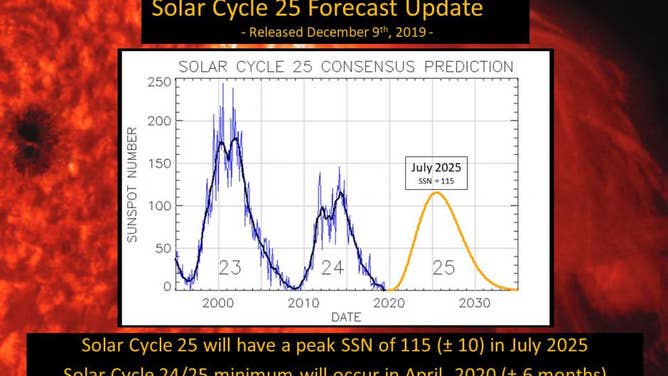What is the 11-year solar cycle?
NASA scientists have learned that every 11 years, the sun's magnetic poles change their polarity, a process that affects solar activity.

Eleven years in the life of the Sun, spanning most of solar cycle 23, as it progressed from solar minimum (upper left) to maximum conditions and back to minimum (upper right) again, seen as a collage of ten full-disk images of the lower corona.
(NASA/Goddard Space Flight Center)
The sun is a rather busy place, what with turning hydrogen into helium amid a 27 million-degree core and warming the entire front chunk of the solar system.
But amid the bubbling cauldron of its surface, the sun can emit sunspots and solar flares that thrust an enormous amount of energy out into space along what's known as the solar wind.
Most of the time, the solar wind is deflected by the Earth's magnetosphere. Still, during intense solar flares and what are known as "coronal mass ejections," the solar wind will be strong enough to make it deeper into the atmosphere, triggering brilliant displays of the Northern Lights.
Those bursts of energy, while they can happen at any time, tend to gravitate toward specific years. NASA scientists have learned that every 11 years, the sun's magnetic poles change their polarity -- which means if you had the power to stand near the sun's surface with the universe's most robust compass, what was north today would in 11 years become south… then revert to north 11 years later. (Imagine the chaos for naming conventions if that happened here on Earth: Nearly every decade, North and South Carolina would have to swap names!)
This 11-year oscillation is known as the Solar Cycle, and the changes the sun undergoes during this process affect its solar activity. Solar activity quiets down when the 11-year period is coming up, and the poles pull the switcheroo. This is known as a Solar Minimum.
Then about halfway through the period, solar activity ramps up to where sunspots and solar flares become more frequent and intense. This is known as the Solar Maximum. A few years later, the sun begins to quiet down again, the poles flip again, and the cycle repeats.

(NASA)
The last Solar Maximum was deemed to be in 2013, with December 2019 appearing to be the Solar Minimum -- there is no real set clock to this; scientists declare the maximum and minimum by counting the number and frequency of sunspots. There have been 24 solar cycles tracked so far, with the new Solar Cycle 25 just dawning last September.
Scientists predict we'll reach Solar Maximum this time around July 2025. So over the next few years, expect to hear more about solar flares and solar storms and perhaps more frequent opportunities to see the Northern Lights.
Researchers predict it'll be an overall weak sun cycle, matching Sun Cycle 24's below-average performance for sunspot count and sun energy released. But just because the cycle may end up below average, it doesn't mean the sun can't still occasionally put out intense solar flares.